A find for gourmets - tomato "Moscow delicacy": advantages over other varieties of tomatoes
Tomato Moscow delicacy is a favorite of many gardeners. It occupies a leading position among salad varieties not only because of its excellent taste, but also because of the simple cultivation technique.
Fruits of amazing shape and unusual taste do not leave indifferent the most whimsical gourmet. The high sugar content in ripe vegetables makes it possible to prepare sweet fortified puree from them, which children love so much. Tomato culture takes root in any climate, which makes it possible to breed it in all regions of our country.
The content of the article
Characteristics and description of the variety
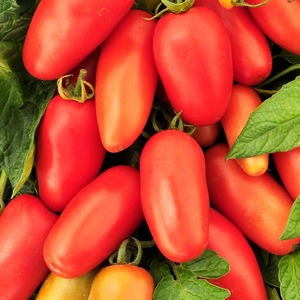 From the name it follows that the tomato belongs to the gourmet varieties with attractive fruits of an unusual shape. It takes root well both in the open field and in greenhouse conditions.
From the name it follows that the tomato belongs to the gourmet varieties with attractive fruits of an unusual shape. It takes root well both in the open field and in greenhouse conditions.
Distinctive features
Indeterminate type, necessarily needs pinching the crown, otherwise it will reach 2.5 m in height... The foliage is dense, the leaves are large, dark green, the stem is powerful. The first brush is laid after 9 leaves, the subsequent ones - every 3 leaves. The inflorescences are simple.
The ripening time is average, from the moment of sowing the seeds to full maturation, 115-120 days pass. Fruiting is extended, until the very frost.
The yield is excellent, up to 5 kg of fruits are harvested from 1 seedling, provided that 4 plants are placed per 1 sq. m.
The culture is characterized by increased immunity to the main diseases of the nightshade family. Needs thinning, mandatory pinching and garter tall plants.
reference... Do not confuse tomato Moscow delicacy with hybrid Moscow delicacy creamy f1. These are different varieties that differ significantly from each other.
Fruit characteristics
The average weight of one fruit is 100-120 g, the shape is not typical for tomatoes, pepper-shaped. The color is bright red, the pulp is not watery, juicy, the taste is excellent, with a high sugar content, vaguely resembles the taste of bell pepper. The rind is dense, not prone to cracking.
reference... The first ripe vegetables are smaller in comparison with the subsequent ones, which distinguishes the culture from other varieties.
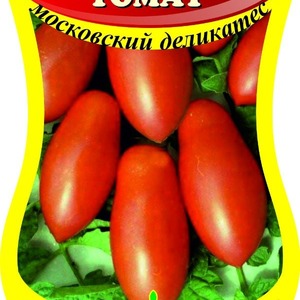 Ripe vegetables are subject to long-term storage, perfectly preserving their presentation, and can withstand transportation over any distance. For these reasons, entrepreneurs breed culture for commercial purposes. Due to their taste and unusual appearance, tomatoes are in great demand in the sales markets.
Ripe vegetables are subject to long-term storage, perfectly preserving their presentation, and can withstand transportation over any distance. For these reasons, entrepreneurs breed culture for commercial purposes. Due to their taste and unusual appearance, tomatoes are in great demand in the sales markets.
The photo shows tomatoes Moscow delicacy.
How to grow seedlings
Sowing seeds for seedlings begins 2 months before planting in the ground. Before sowing, the planting material undergoes mandatory training.
Seed preparation
Seeds are carefully checked for visible defects: damage, distortion. The dark color of the seed indicates its non-viability, suitable seeds are only light in color. Next, the seed is checked for emptiness inside. To do this, dissolve 1 teaspoon of salt in 1 glass of water and place grains in it. Those suitable for sowing remain on the bottom of the glass.
After that, the grains are disinfected in a weak solution of potassium permanganate for 20 minutes. Then washed with running water and dried.After disinfection, only viable specimens remain, capable of giving strong shoots.
To improve germination, the seeds are soaked for 12 hours in a growth stimulator or in melt water and aloe juice.
reference... The most used growth stimulants are Epin, Zircon, Kornevin.
Capacity and soil
The soil is prepared from garden soil, peat, river sand and wood ash... All components are thoroughly mixed, after which the resulting mixture is disinfected by steaming in the oven for 15 minutes at a temperature of 50-60 ° C.
For disinfection purposes, the prepared soil can be spilled with a hot solution of dark potassium permanganate. This procedure is necessary for the destruction of pathogenic flora, which leads to the further healthy growth of seedlings.
reference... River sand is added to the soil for looseness. Tomatoes love loose and fertile soil.
The prepared soil is filled halfway with the planting containers, having previously made small drainage holes at the bottom. The remaining soil is poured into containers as the seedlings grow. This technique provides additional receipt of nutrients during the seedling period.
They are planted in a common wooden box or in an individual container. Sowing in separate containers further reduces seedling care to a minimum.
Sowing
The seed is sown to a depth of 1.5-2 cm with a distance of 2-3 cm from each other. Sprinkle with earth on top, level it, slightly moisten it with warm, settled water and cover the containers with film or glass to create a greenhouse effect.
The landing container is left in a bright and warm room at a temperature of at least 25 ° C. Before germination, the film is periodically removed and the topsoil is moistened as it dries.
Further care of seedlings
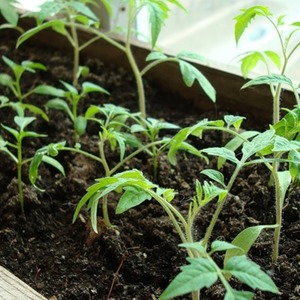 When seedlings appear, the containers are rearranged to the windowsill, but not to direct sunlight... Daylight hours for seedlings are 15-16 hours, so there is a need for supplementary lighting with phytolamps. In case of insufficient light, seedlings are stunted.
When seedlings appear, the containers are rearranged to the windowsill, but not to direct sunlight... Daylight hours for seedlings are 15-16 hours, so there is a need for supplementary lighting with phytolamps. In case of insufficient light, seedlings are stunted.
Watered in moderation, without flooding the sprouts, with warm, settled water using a shallow watering can. After watering, the soil is gently loosened, thereby providing better oxygen penetration to the young roots.
When 3-4 true leaves appear, the seedlings dive, seating them in separate containers. If the seeds were sown in individual containers, picking is not required. The picking procedure is to remove the main root by one third. This technique leads to the growth of lateral roots, due to which a powerful root system is formed.
2-3 weeks before transplanting, the seedlings begin to harden, taking the seedlings out into the open air for 1 hour at a temperature of 16-17 ° C. Gradually the time interval is increased to 12-13 hours. Simultaneously with the daytime hardening, the night temperature is reduced to 12 ° C.
reference... Hardening helps young plants to adapt more quickly to outdoor conditions.
How to grow tomatoes
After 2 months, the seedlings are ready to be transplanted to a permanent place. Tall tomatoes usually outgrow during the seedling period, reaching 40-45 cm in height. This important feature does not allow the bushes to be planted vertically, so they are placed in a half-lying hole.
Landing
Planting pattern: 50 cm - distance between seedlings, 70 cm - distance between rows. For 1 sq. m place 3-4 plants.
The culture is transplanted in the evening or early morning, when the sun does not warm at full strength. Only planted tomatoes do not like direct sunlight, so it will be difficult for them to adapt to new conditions under unfavorable factors.
Wells are made in advance with a depth of 20 cm, pre-watered abundantly with warm water. After transplanting, young bushes are watered again with warm water, the earth is compacted and left to get used to constant conditions for at least 8 days.
Care
Regular watering set as the seedlings adapt.It is watered no more than 2 times a week, but during flowering and fruit formation, the culture requires more moisture. Also, watering is increased during hot and dry days. Watered only with warm, settled water, under the root of the plants, without getting on the leaves.
Attention! Cold water has a detrimental effect on tomatoes. They stop growing and developing.
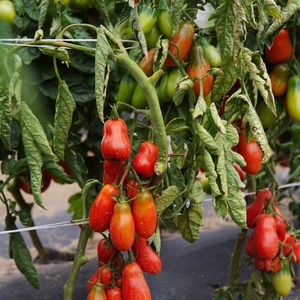 After watering, the beds are loosened, removing all weeds with roots. Many insect pests breed in weeds, so it is necessary to clean the beds of unnecessary plants. Weeds can be used as mulch; when rotting, it enriches the soil with many useful substances. Also, straw or peat is used for mulch. Mulching retains moisture in the beds longer.
After watering, the beds are loosened, removing all weeds with roots. Many insect pests breed in weeds, so it is necessary to clean the beds of unnecessary plants. Weeds can be used as mulch; when rotting, it enriches the soil with many useful substances. Also, straw or peat is used for mulch. Mulching retains moisture in the beds longer.
The stem of the bush is so powerful that the culture does not need the obligatory dressing... The developed root system is quite capable of nourishing the plants itself with the substances necessary for full development. But experienced gardeners bring in wood ash, which not only feeds the plant, but also protects it from fungal diseases.
Features in care and possible difficulties
The quantitative indicator of fruiting depends on the formation of the bush. To increase yields, experts advise to cultivate 2 stems, avoiding thickening of the plantings. To do this, remove all the stepsons, leaving only one shoot under the first flower brush. Patching is carried out periodically, as unnecessary shoots grow.
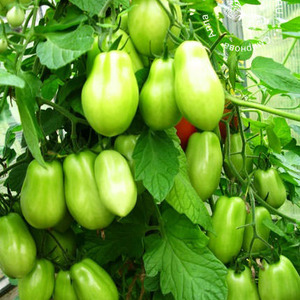 To restrict growth, it is necessary to pinch the crown, otherwise, without determining the point of growth, the plant will grow up to 2.5 m. Restricting growth prevents the development of unnecessary branches that will take away the necessary nutrients for its development.
To restrict growth, it is necessary to pinch the crown, otherwise, without determining the point of growth, the plant will grow up to 2.5 m. Restricting growth prevents the development of unnecessary branches that will take away the necessary nutrients for its development.
Plants need tying up immediately after transplanting. For this, trellises are installed - this is the best option for solving the problem. As development progresses, fruiting branches are fixed to the support without fail. Many fruits are tied, and the branches do not support their weight.
Diseases and pests
Strong immunity distinguishes the crop from other salad varieties that are susceptible to many diseases.... However, prevention against late blight is necessary, since prolonged fruiting can cause a fungal infection.
Preventive measures include: systematic loosening, moderate watering with control of the humidity level in the beds, removing weeds and ventilating closed structures if the tomato is planted in a greenhouse. Also, before planting, the land is treated with copper sulfate, which destroys fungal spores.
Of the pests for tomato, the most dangerous are aphids and a whitefly butterfly. For aphids, a soap solution is used, which is used to treat the plant stem. The solution is prepared from 1 piece of laundry soap dissolved in 1 bucket of water. If there are a lot of aphids, the whole plant is treated.
Advice... The sharp-smelling herbs planted next to the tomato - calendula, marigolds - protect the crop from many ground and flying pests, including the whitefly. Pheromone traps installed next to the bushes are also used to fight the parasite.
The nuances of cultivation in open ground and in greenhouse conditions
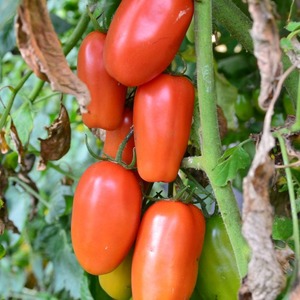 Indeterminate types do not have a growth restriction point... It is for this reason that the tops of the heads are pinched, otherwise the bushes with further growth will consume nutrients on unnecessary green mass, and not on the formation of fruits.
Indeterminate types do not have a growth restriction point... It is for this reason that the tops of the heads are pinched, otherwise the bushes with further growth will consume nutrients on unnecessary green mass, and not on the formation of fruits.
Removing the lower leaves helps aerate the plants and soil in the holes. This important factor prevents fungal spores from developing.
Watering with cold water is detrimental to the culture. The water must be warm and settled. To do this, barrels are installed on the garden plot, which are filled 2-3 days before watering. During this time, the water has time to warm up in the sun.
Water in the evening or in the morning so that the leaves do not get sunburn.Moderate watering, correct plant formation and soil fertility have a positive effect on fruiting.
Harvesting and application of the crop
The culture has a peculiarity: the first fruits are much smaller than the subsequent ones. For this reason, the first tomatoes are left for whole-fruit canning, which, due to their elongated shape, easily fit into jars.
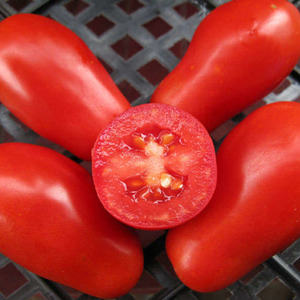 The variety belongs to salad, so ripe vegetables are great for fresh use. Due to their high sugar content, they are ideal for baby purees. Tomatoes are used for processing for tomato products: adjika, lecho, ketchup, juices. During heat treatment, the peel does not crack, so the tomatoes are stuffed and frozen.
The variety belongs to salad, so ripe vegetables are great for fresh use. Due to their high sugar content, they are ideal for baby purees. Tomatoes are used for processing for tomato products: adjika, lecho, ketchup, juices. During heat treatment, the peel does not crack, so the tomatoes are stuffed and frozen.
Tomatoes tolerate long-term storage and long-term transportation well, while perfectly maintaining their presentation.
Advantages and disadvantages
The benefits of vegetable crops include:
- unpretentious care;
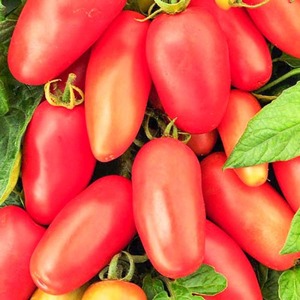
- the ability to take root in any region;
- high yield;
- persistent immunity to diseases;
- the possibility of self-selection of seeds;
- great taste;
- unusual shape;
- transportability of fruits;
- long storage;
- universal application.
Negative characteristics include the obligatory garter of tall shrubs and regular pinching. This also includes the need to pinch and thin out densely leafy plants.
Farmers reviews
Reviews of the Moscow delicacy tomato variety are only positive. For many fans of salad varieties, these tomatoes are in priority.
Maxim, Taganrog: «For a long time I have chosen a variety that does not require special care. I decided to opt for Delicatessen. The result is interesting. Tomato bushes are really unpretentious. They grow well, fruits with an unusual taste, reminiscent of the taste of bell pepper. Overall, I liked it. "
Nikolay, Vologda: “If you don’t want to take too much care, but you want to get a good and unusual harvest, your choice is the Moscow delicacy. I planted and forgot. By the way, an interesting fact is that each subsequent fruit is larger. Thus, small tomatoes grow first, and then quite large vegetables. "
Conclusion
Fans of unusual tomatoes can pamper themselves with another development of Russian selection. Tomato Moscow delicacy looks great not only in photographs, but also on any table.
Bright peppery vegetables with a characteristic taste will surprise any gourmet. The culture is unpretentious to care for, resistant to diseases and high-yielding, which is an excellent addition to excellent taste characteristics.